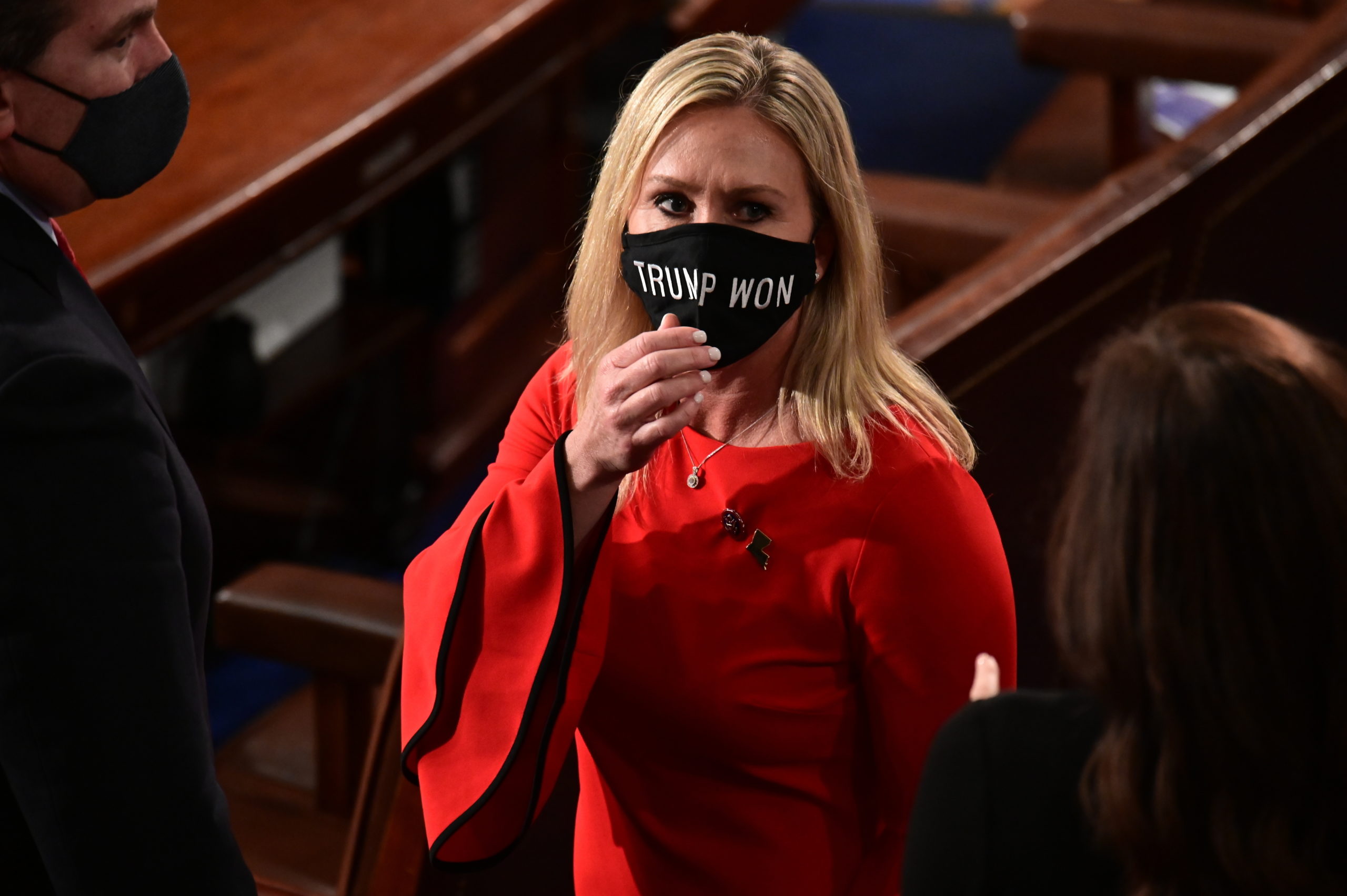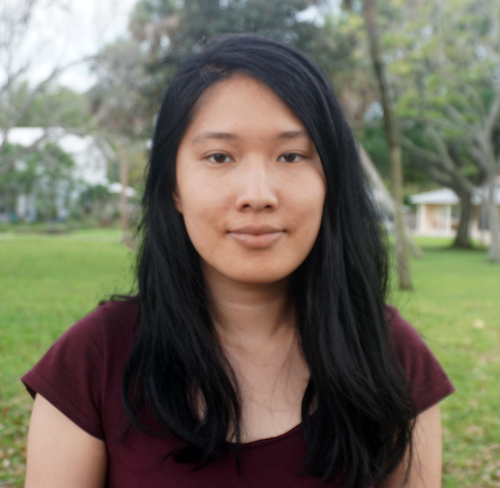BBC reporter Marianna Spring was sitting outside enjoying a pint with one of her friends last summer when she got hit by her first QAnon pile-on.
Messages and threats flooded Spring’s phone, accusing her of eating babies and of being a Satanic pedophile. Spring, a specialist reporter covering disinformation and social media, stayed up until 3 a.m. that night, blocking accounts until the deluge of harassment slowed. When she woke up, more messages awaited her.
“I think it was then that I really realized what QAnon is, the scale of this movement, the cult-like nature of it, and how it was beginning to become a bit of a big deal here in the U.K.,” Spring said.
QAnon – the baseless conspiracy theory centered on the idea that prominent Democrats and Hollywood celebrities are cannibalistic, Satan-worshiping pedophiles – has exploded in popularity over the past year. It has gained traction in the United States among former President Donald Trump’s supporters, and its ideas have spread abroad.
A December 2020 NPR/Ipsos poll found that 17% of respondents said they believe a “group of Satan-worshipping elites who run a child sex ring are trying to control our politics and media,” and 37% said they did not know whether the statement was true.
“QAnon really exploited the fear and confusion surrounding the pandemic, and also the political division surrounding the election, and even the nationwide racial justice protests,” said HuffPost senior reporter Jesselyn Cook, who covers disinformation. “2020 was a perfect storm.”
The conspiracy theory originated in 2017 when someone calling themselves Q posted a Trump quote about the “calm before the storm” on 4chan, a notorious online message board. Since then, QAnon has rapidly evolved as new followers join and more niche theories develop. Followers have taken their beliefs into the real world, sometimes in violent ways. Most recently, some QAnon believers took part in the Jan. 6 insurrection at the U.S. Capitol.
A growing number of journalists are tracking QAnon, reporting on everything from the way social media algorithms help spread conspiracy theories to the people who lose loved ones to the movement. With each story, they debate whether their reporting will contribute helpful information or simply amplify the movement. Their goal is to make readers — lawmakers, tech companies, the general public — understand the gravity of the problems QAnon poses.
“Online conspiracies and disinformation are no longer a fringe internet quirk, but something that has a huge bearing on real life,” Spring said. “The riots at Capitol Hill … very starkly exposed how much damage these conspiracies online can really do.”
The tipping point

A protester holding a QAnon sign waits in line with others to enter a 2018 campaign rally with President Donald Trump in Wilkes-Barre, Pa. (AP Photo/Matt Rourke)
Though QAnon has only recently started making national headlines daily, some reporters have been monitoring the movement for years.
CNN reporter Donie O’Sullivan is one of them. During the conspiracy theory’s early days, he kept tabs on it but didn’t do much reporting out of concern that CNN’s global platform would spread the theory.
“Where is the tipping point of yes, there is something happening on the internet, and yes, some people are engaging, but by us covering it, are we unintentionally giving it more oxygen?” O’Sullivan said.
Brandy Zadrozny, an investigative reporter at NBC News, faced a similar dilemma. She first heard about QAnon from her reporting partner Ben Collins in November 2017 but didn’t publish her first article on it until 2018.
The appearance of QAnon supporters at Trump rallies in 2018 made Zadrozny realize that QAnon was not just another conspiracy theory, but something that needed coverage.
“It’s when conspiracy theories move from online to IRL that we sort of feel like we need to explain who these people are that you might be seeing on your TV,” Zadrozny said. “What we don’t want people doing is seeing the stuff either in real life or on television and then googling it when there’s no responsible journalism out there on it.”
Several other reporters pointed to the 2018 Trump rallies as the moment when they realized that QAnon could grow into something much bigger. The sudden rise of the movement shortly after the start of the pandemic was another clear inflection point.
These days, because QAnon beliefs have become so widespread, there is not as much concern that simply covering the movement will further amplify it. Rolling Stone culture reporter EJ Dickson compared it to the dilemma reporters initially faced while covering Trump.
“Trump has the biggest platform in the world, and media and newsrooms were grappling with whether or not they were amplifying his message by covering the crazy and horrible things he said,” Dickson said. “But at the same time he already had the biggest platform in the world, so it was sort of like you were turning a blind eye to it if you didn’t cover it.”
“I think the same argument could be made about QAnon,” she said. “At this point, the horse is already out of the barn. It is already a problem.”
Tracking the movement

Child Lives March outside Netflix in Hollywood, CA, on Sept. 19, 2020. QAnon followers have hijacked the anti-human trafficking hashtag #SaveTheChildren. (AP Photo)
QAnon may have started on 4chan, but content related to the conspiracy belief has spread to most of the major social media platforms, including Twitter, Facebook, Instagram and YouTube.
Though there are a few core tenets accepted by most QAnon believers, there exist many more niche sub-conspiracy theories, each with their own small following. Many describe QAnon as a “big tent” because so many different conspiracy theories are associated with the movement.
Sometimes people support and spread QAnon-associated ideas without realizing those ideas are part of the conspiracy theory, further complicating matters. For example, the hashtag #SaveTheChildren, which is ostensibly about preventing child sex trafficking, is linked to QAnon.
To track all these conversations, some journalists monitor the social media sites and internet forums where QAnon theories are spread and shared. Daily Beast politics reporter Will Sommer, for example, keeps a list of 30 to 40 right-wing blogs, forums and other websites that he searches through once a day. He also regularly skims a list of Telegram groups.
“You’re like a big whale, and you just swallow as much as you can, and you have to filter it out through your baleen,” said Sommer, who is working on a book about QAnon. “You want to spot the trends, and you want to spot things that are being repeated over and over. And so, in that case, I have to just consume huge amounts of it to spot these connections.”
That work has gotten more difficult in recent weeks as social media platforms start to crack down on QAnon content. Twitter, for example, has removed more than 70,000 QAnon accounts.
Zadrozny used popular journalism tools to monitor QAnon. She used to keep TweetDeck open with a Twitter list of QAnon accounts. She also had a CrowdTangle dashboard for pages related to the conspiracy theory and a YouTube channel following QAnon creators.
“Now, it’s harder. Now, we’re talking about Discord chats. Now we’re talking about audio chat rooms. Now, we’re talking about Telegram channels,” Zadrozny said. “So it’s just being extremely online, having a billion tabs and following these people as they are moved into more niche platforms.”
To ensure that they are accurately identifying major trends, some reporters check their findings with researchers who spend more time in QAnon spaces.
They also rely on former QAnon believers for tips and track the posts of QAnon influencers, who help set certain talking points. Those talking points are “extremely well organized,” said O’Sullivan. He said it is fairly easy to identify the conspiracy theory of the day because it will spread across QAnon spaces.
O’Sullivan saw the spread of QAnon talking points in real time on Jan. 6, when he covered the riots at the U.S. Capitol. As people left the Capitol grounds, he asked them about the violence that had taken place earlier that day. They told him antifa had been responsible.
“As people were coming down, they were saying, ‘Oh, the violence, the destruction — that was antifa.’ And this is from people actually walking, leaving the place,” O’Sullivan said. “That was notable to me because at that point, the conspiracy about antifa and left-wing agitators and Trump supporters not actually being responsible for this destruction was spreading online. It was just remarkable how quickly in unison people can get behind the baseless talking points.”
In addition to tracking QAnon chat rooms, Cook said she spends a lot of time “reverse engineering” conspiracy theories. Once she identifies a viral piece of mis- or disinformation, she works backwards to understand where it came from, who promoted it, and why.
“With so many of the conspiracy theories that we saw this past year, the first mention of it on Twitter would be from a QAnon account. Or you would look on 8chan or 8kun, and you would see two people spreading this before it reached Twitter and before it reached Fox News and before it went viral,” Cook said.
Spending a lot of time reporting on QAnon and absorbing outlandish conspiracy theories can take its toll, Dickson said. Journalists risk becoming desensitized to the theories. She pointed to the recent news about Rep. Marjorie Taylor Greene (R-Ga.) as an example. Though many were surprised to hear that Greene thinks “Jewish space lasers” caused wildfires in California, the news did not shock Dickson as that theory is in line with what many QAnon followers believe.
“It’s sort of like putting a frog in slowly boiling water. You become very acclimated to the discourse and things become less and less surprising to you,” Dickson said. “I try very hard to sort of unwind at the end of the day, spend time with my family, talk to people who aren’t part of a mass delusion to sort of try to rid that from my brain.”
Avoiding amplification

A QAnon supporter marches in route to the Supreme Court during the Million MAGA March protest regarding election results on Nov. 14, 2020 in Washington D.C. (AP Photo/Chris Tuite)
Reporting on a conspiracy theory responsibly takes extra sensitivity and precaution.
When they’re identifying stories, many reporters avoid treating the movement as a spectacle and repeating the latest bizarre conspiracy theory. They instead try to identify tangible impacts, which helps them avoid amplifying smaller theories.
“Instead of just noting that QAnon believers are believing in X thing and have pinned all their hopes on this date, I’ll try to find something about how QAnon believers are advocating for violence or if they’re organizing on a specific platform and causing problems,” said Ali Breland, a disinformation reporter for Mother Jones. “They’re things that can ideally, hopefully be resolved if there’s attention to them or things that are useful information for people.”
The language journalists use matters, too. Insider digital culture reporter Rachel Greenspan said she avoids referring to QAnon as a “group” since it does not have a leadership hierarchy or formalized rules. Rather, it is a belief system.
“We want to make sure we’re not using language like ‘a member of QAnon’ because that’s actually giving it way more power than it even has,” Greenspan said.
She also tries to be very specific in her reporting. When she reports on a smaller, niche conspiracy theory, she does not ascribe the belief to all QAnon followers but instead contextualizes it within the larger movement.
Though many reporters have interviewed QAnon followers in the past, some try to avoid doing so. Naturally, some followers are hostile towards journalists, who they see as part of the Satanic cabal, and the information they give journalists is unreliable. But issues also arise when QAnon followers seek out media coverage, which they believe legitimizes their beliefs.
“A big message in the QAnon community is basically the idea of why are you giving so much attention if it’s not real?” Zadrozny said. “Because if not, if it wasn’t right, then why would the media care about a stupid conspiracy theory? It’s this sort of circular logic.”
Dickson said she avoids naming QAnon influencers, many of whom have profited from the movement, so as not to unwittingly lead more people to them. She also tries not to interview active followers as she does not find them helpful.
“These are people who are embedded within a mass delusion,” said Dickson. “They believe what they believe, and what they believe is wrong. And it’s not going to help your audience or anybody really to understand this phenomenon by highlighting that.”
Naturally, any reporting on a conspiracy theory must also be accompanied by rigorous fact-checking. O’Sullivan breaks down what is false at the beginning and the end of an interview. Similarly, Greenspan debunks every conspiracy theory she references in a story.
As time passes, some QAnon believers will likely ditch the conspiracy theory. Inauguration Day brought a moment of clarity for some as the promised “storm” — when Trump was supposed to declare martial law and round up and execute Democrats — never came.
These shifts raise questions on how best to report on former believers, and it’s an issue Greenspan has been thinking about lately.
“There’s a fine line you have to tread between humanizing and empathizing with these people who have been manipulated basically by a cult in a way, versus like, OK, but these are also people who have supported something that accuses innocent people of being a pedophile,” Greenspan said.
Years to come

Rep. Marjorie Taylor Greene, R-Ga., wears a “Trump Won” face mask as she arrives on the floor of the House to take her oath of office on opening day of the 117th Congress at the U.S. Capitol in Washington. Greene has expressed support for QAnon in the past. (AP Photo/Erin Scott)
Though Trump is out of office, the conspiracy theory continues to retain believers, even among the highest levels of government. In addition to Greene, Rep. Lauren Boebert (R-Colo.) has voiced support for QAnon.
“There seems to be hope or a belief that QAnon is going to fade away now that Trump is out of office,” Cook said. “This movement has roots in so many other disinformation groups and it’s not going anywhere. It’s something that we’re going to be dealing with for years to come.”
Several journalists said they hope their reporting on QAnon will make people take it seriously. In their interviews with people who have lost loved ones to the conspiracy theory, reporters get a “front row seat” — as Cook puts it — to the wreckage QAnon can cause families. The problem is so widespread that grieving family members have created online support groups.
“When I talk to people who have close people in their lives who have become really, really, really invested and devoted in QAnon, they’re describing pain at losing a person. These conversations are generally about grief,” said MIT Technology Review senior editor Abby Ohlheiser. ”I never get used to those conversations. Those are always hard every time.”
QAnon’s reach extends beyond fraying relationships. Its influence on the Stop the Steal movement and the Capitol Hill riots has proved it has implications for people’s trust in American democracy.
And so, according to Sommer, the question QAnon poses is this: What happens to a country when a huge percentage of people buy into a delusion and leave reality?
“Unfortunately, what happens is we see at the family level, people getting alienated from their families. We see people committing crimes, murders and terrorism. Then we see things like Marjorie Taylor Greene getting into Congress,” Sommer said. “I think that is my biggest question, or what I hope (my) reporting helps grapple with.”
This article was originally published on Feb. 9, 2021.







